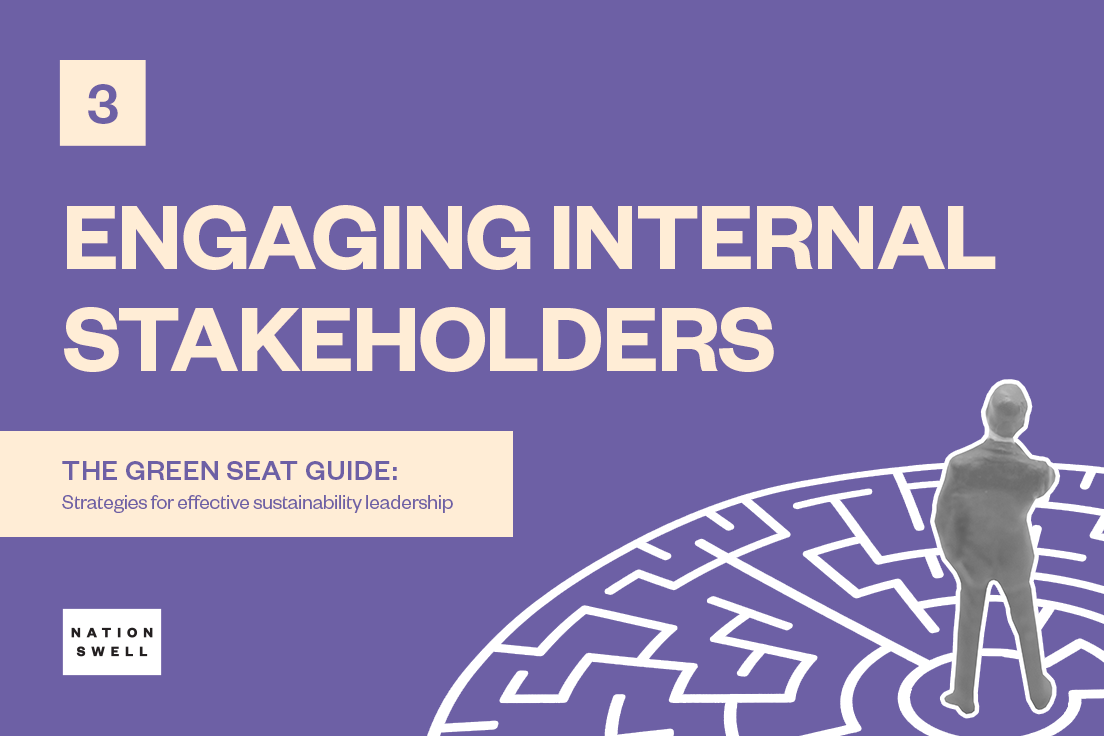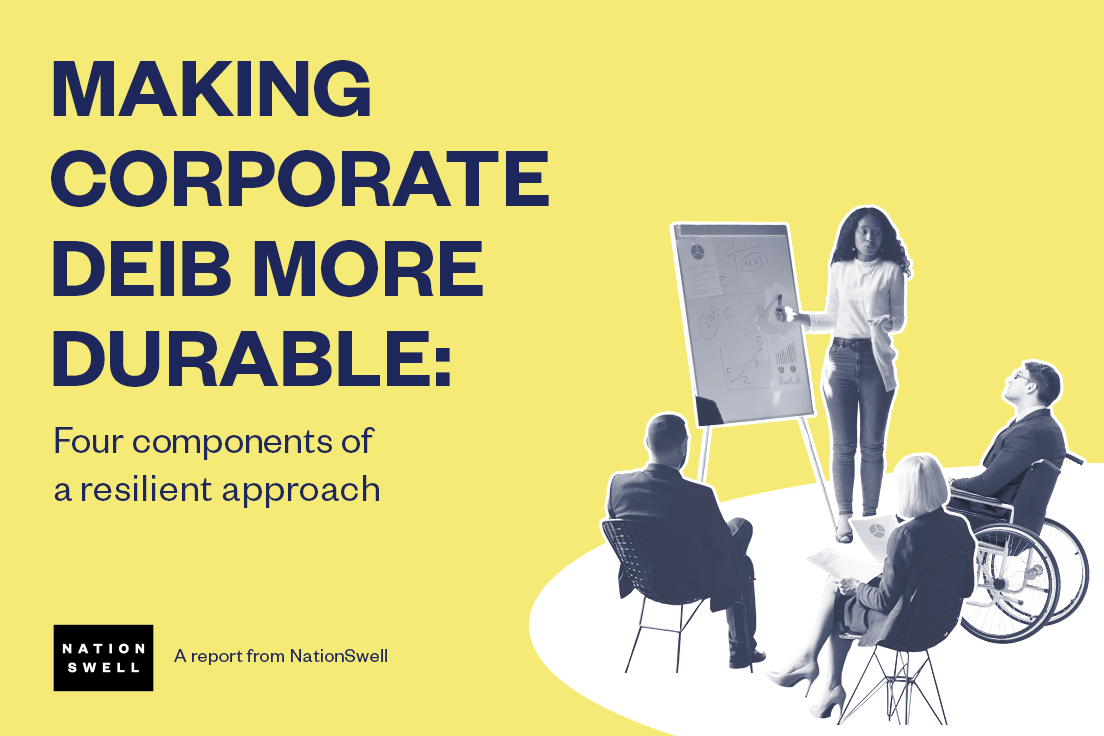Resource Type: Executive briefings
The Green Seat Guide, Chapter 2
The Green Seat Guide, Chapter 2

As corporate sustainability challenges grow more complex, chief sustainability officers (CSOs) are being hired at record rates. They come from diverse professional backgrounds, underscoring the multidisciplinary nature of the role, and often find themselves navigating uncharted waters, tasked with steering an entire enterprise toward ambitious goals. This mandate demands more than just technical knowledge, it demands leadership, vision, and the ability to inspire change at all levels.
While technical guidance on sustainability is widely available through consultants, vendors, and the scientific community, there remains a significant gap in the transfer of practical wisdom. The Green Seat Guide bridges that gap with insights, strategies, and lessons learned from experienced sustainability executives. The aim of the guide is to accelerate the impact of sustainability leaders, new and experienced, by offering practical guidance and learned wisdom from those who have pioneered the role.
Each chapter focuses on an essential component of the sustainability journey and includes a selection of ready-to-use tools to support the adoption of key ideas and tactics.
Chapter 2 – Organizing your team
With a strategy in hand, creating and deploying a well-rounded sustainability team is the sustainability executive’s next most important task. Whether you’ve inherited a staff or need to build a team from scratch, you should be mindful of balancing your technical needs with your strategic needs. Your team will need to be rigorous, detail-oriented, and versatile, and you will need to build key cross-functional relationships beyond your direct reports.
Chapter 2 of The Green Seat Guide provides guidance on building a successful sustainability team, drawing on the rich insights of those who have done so before.
It is comprised of four sections:
- Working with consultants
- Designing your core team
- Sourcing and screening the right talent
- Leveraging existing internal capabilities
For insights on developing a sustainability strategy, don’t miss Chapter 1.
Making corporate DEIB more durable
Making corporate DEIB more durable

Diversity, equity, inclusion, and belonging (DEIB) professionals are facing heightened political and legal opposition to their day-to-day work. At times, it’s challenging to truly know if and how companies, and DEIB leaders themselves, are shifting their commitments or approaches.
The reality is that some businesses are pausing or re-evaluating their DEIB strategies. A number of companies are reducing investments in DEIB or choosing to proceed more quietly. But the pendulum is swinging in both directions. There is evidence that the material work of DEIB has endured and will continue to endure.
Based on interviews with chief diversity officers and other DEIB executives, this report is intended to support leaders and organizations in confidently charting a path forward at a moment of heightened scrutiny.
The resource teaches the four components of a resilient approach to corporate DEIB and includes tactical guidance, real-world examples, and implementation tools.
The four components:
- Leverage data as the backbone of your commitment
- Cultivate and activate accountable champions at all levels of the organization
- Center transparency, honor progress, and strive for continuous improvement
- Get intentional about future-proofing DEIB
The Green Seat Guide, Chapter 1
The Green Seat Guide, Chapter 1

As corporate sustainability challenges grow more complex, chief sustainability officers (CSOs) are being hired at record rates. They come from diverse professional backgrounds, underscoring the multidisciplinary nature of the role, and often find themselves navigating uncharted waters, tasked with steering an entire enterprise toward ambitious goals. This mandate demands more than just technical knowledge, it demands leadership, vision, and the ability to inspire change at all levels.
While technical guidance on sustainability is widely available through consultants, vendors, and the scientific community, there remains a significant gap in the transfer of practical wisdom. The Green Seat Guide bridges that gap with insights, strategies, and lessons learned from experienced sustainability executives. The aim of the guide is to accelerate the impact of sustainability leaders, new and experienced, by offering practical guidance and learned wisdom from those who have pioneered the role.
Each chapter focuses on an essential component of the sustainability journey and includes a selection of ready-to-use tools to support the adoption of key ideas and tactics.
Chapter 1 – Developing a sustainability strategy
Crafting a sustainability strategy is a foundational, if daunting, part of a sustainability leader’s mandate. Success requires rapid, comprehensive learning about a complex enterprise and a nuanced grasp of the forces that motivate your key stakeholders.
Chapter 1 of The Green Seat Guide explores the art of crafting a sustainability strategy, drawing on the rich insights of those who have navigated this process before.
It is comprised of seven sections:
- Getting to know your business inside and out
- Roughing out a draft strategy
- Conducting a materiality assessment
- Defining top strategic priorities
- Setting targets
- Roadmapping and resourcing your sustainability strategy
- Engaging with external coalitions, pledges, and third-party validation
The chapter also offers tools to support the adoption of key ideas and tactics, including:
- Tool A: Sustainability landscape assessment checklist
- Tool B: Preferred consulting and technology solutions
- Tool C: Sustainability accountability map components
- Tool D: Overview of commonly used sustainability reporting frameworks
- Tool E: Materiality assessment preparation checklist
- Tool F: Essential elements of a sustainability roadmap
- Tool G: Common product sustainability certifications
Civics Inc.
Civics Inc.

This is the biggest election year in history, as citizens in countries representing half the the world’s population head to the polls. At home, the 2024 U.S. election will once again put destabilizing pressure on American political processes and institutions.
We know that the moment demands more than our attention; it demands urgent action. Employers hold outsized potential to promote civic participation and protect our democracy, but for many leaders, that work feels more fraught than ever before.
Developed from the insights and experiences of business leaders and democracy experts, this report is designed to meet businesses where they are. It provides a strategic framework to help employers customize their efforts around three goals and five core assets.
Three goals for employers to pursue in service of healthier democracy:
- Encouraging and enabling civic participation
- Promoting information accessibility, transparency, and quality
- Supporting issues that protect fundamental rights and protect democracy
Five core assets that all businesses can leverage in pursuit of these goals:
- Workplace policies and benefits
- Employee engagement and people infrastructure
- Corporate products and services
- Political contributions and advocacy
- Corporate and executive voice
What else is included in the report?
- Talking points for making the business case for democracy, provided directly by corporate leaders and democracy experts
- Dozens of real examples showing how businesses are promoting civic participation and a healthier democracy, paired with detailed implementation guidance
- Peer-vetted recommendations for partner organizations on a wide-range of needs
Guide to engaging employees in corporate volunteerism
Guide to engaging employees in corporate volunteerism
A majority of employees (69%) report that “having societal impact is a high expectation or deal breaker when considering a job” (Edelman Trust Barometer, 2023). By facilitating volunteerism, companies can help to meet growing employee interest in purpose-driven work environments while harnessing the power of individual and collective contributions to drive impact.
Generally, employees are eager to have access to volunteer opportunities through work. Seventy-one percent of employees say it’s imperative or very important to work at a company that is supportive of giving and volunteering (America’s Charities, 2022), and they attribute volunteerism to well-being (77%), boosted morale (70%), and strengthened camaraderie (64%) (Bright Funds, 2021). Additionally, 92% of corporate human resources executives feel that leadership and professional skills are strengthened by contributing expertise to nonprofits (Deloitte, 2017).
However, volunteer participation is decreasing. In 2022, 86% of companies offered domestic virtual volunteerism programs but only 19.8% of employees volunteered one hour or more of their time – lower than the pre-pandemic average of 29% (CECP, 2023). Nonprofit organizations are noticing this downward trend. In a recent survey, 47% of nonprofit CEOs said that recruiting sufficient volunteers is a notable problem for their organization (Do Good Institute, 2023).
Given the increased value that employees place on working within purpose-driven environments, what explains the decline in volunteerism? Workers cite the following major detractors from volunteering: pressure from employers and colleagues, no availability during work hours, undefined projects, limited information about NGOs, and lack of a platform to register, participate, and track hours (America’s Charities, 2022). Moreover, few feel that volunteering can enhance their career opportunities (18%) or help to develop new skills (36%) (Deloitte).
Gathered from NationSwell members and independent research, this resource provides strategic guidance, case examples, and implementation checklists for companies to strengthen and advance their volunteerism efforts, with a specific focus on mitigating barriers and increasing incentives for employees.
In this report you will find:
- Four critical areas of strategic guidance surfaced by NationSwell members
- Case examples of strategies in action, featuring Mastercard, PwC, LinkedIn, Nike, Dow, Salesforce, Coupa, Starbucks, MetLife Foundation, KPMG, Liberty Mutual, Medtronic, Bank of America, and Verizon.
- Implementation checklists to support action
Pivotal moments: Responding to social, cultural, and political events
Pivotal moments: Responding to social, cultural, and political events
Frequent media headlines, debate on our national stage, and marked instances of backlash toward companies have mainstreamed the politicization of ESG. Although the underlying work of corporate social impact and sustainability remains in-tact and durable, newly mounting political pressures have created real headwinds for business leaders — headwinds that can fundamentally change how social impact and sustainability are practiced. To get more clarity on what impacts political backlash is having on corporate practices, NationSwell surveyed 74 corporate ESG leaders (VPs and above), and conducted in-depth interviews with 12 more (whose ranks include senior leaders from Fortune 100 and 500 companies).
Our research surfaced one significant way that political pressure is impacting company behavior: it has sown a growing reluctance to speak out publicly on culturally sensitive and politically divisive topics.
Whereas the social justice movements of 2020 normalized the activist CEO, the current moment is introducing new doubt in the boardroom and among management teams about the relative risks and rewards of taking public and participatory action when an issue is polarizing. If harnessed intentionally, this trepidation can provide a useful moment for companies to reflect, reevaluate, and reset the purpose and impact behind public responses. Companies need to consider their own credibility and opportunity for meaningful impact before making bold public statements or commitments. But too much restraint can be overcompensatory and damaging, both to society and to corporate interests.
As we look ahead to continued global instability and social turbulence, the acuity of questions around if, when, and how to respond to social and political issues will only grow. In conversation with leaders and practitioners, we’ve surfaced four recommendations for companies to help them navigate ESG headwinds while considering the interests of their employees, customers, communities, and other stakeholders. These recommendations will be most effective if implemented together. We have also created four tools to support their direct implementation.
Recommendations:
- Create mechanisms for understanding what employees and customers expect of your organization
- Assess the impacts of sociopolitical issues on your company, and your company’s opportunity to influence those issues
- Use a decision framework to weigh and resolve the best available information before acting
- Consult an external advisory council to expand your perspective
Implementation tools:
- Employee sentiment survey questions
- How to create a social response scorecard
- Template corporate social response scorecard
- Template Community Advisory Council charter
Skilling the future workforce: 8 recs for corporate leaders
Skilling the future workforce: 8 recs for corporate leaders
Private sector engagement with skills-based hiring is increasing in response to employment gaps and escalating economic precarity. Between 2017 and 2019, 46% of middle-skill and 31% of high-skill occupations experienced material degree resets. And in 2022, 79% of HR professionals reported that scores on skills assessments are just as or more important than traditional criteria in hiring decisions.
These are positive trends from an economic and a social perspective. Skills-based hiring is critical to increasing equity and diversity in the workplace, as traditional credential-based hiring tends to screen out, disqualify, or exclude applicants without a four year degree.
While increased commitment to skills-based hiring is an important step toward a more prepared and more inclusive workforce, many companies are learning that in-demand skills do not exist in adequate supply. Some of those businesses are taking it upon themselves to develop the skill-based talent pipeline that will be necessary to power their organizations, industries, and broader market into the future.
To better understand how companies are investing in the skills-based training ecosystem, before hiring even comes into frame, we dug deep with nine organizations on the cutting edge of workforce development.
Through our conversations with leaders and practitioners, we uncovered a depth of contributions to changing and scaling the learning systems that are preparing workers for quality jobs. Our report compiles eight recommendations to provide guidance for private sector employers who are committed to skilling the future workforce and ultimately contributing meaningfully to a more just and equitable workplace.
The eight recommendations:
- Decide if you aim to be influential at a systems, sector, or company level
- Position your strategy correctly within your company’s infrastructure
- Lean into (and use) your company’s strengths
- Build a well-balanced partner portfolio
- Design for replicability and scalability
- Mind the non-skills gap between learner and earner
- Engage in pre-competitive transparency and collaboration
- Bring rigor and patience to impact measurement
Seven critical design choices for corporate impact investors
Seven critical design choices for corporate impact investors
As the global impact investing market surpasses $1 trillion USD, a small yet growing number of companies are adopting the strategy.
Corporate impact investors are motivated by the limitations of traditional philanthropy to fundamentally alter the structural disadvantages of capital markets, the desire to diversify their social impact strategies, the proven possibility of competitive financial returns, and intensifying pressure on the private sector to help finance the UN Sustainable Development Goals (SDGs).
Regardless of their motivation, what these enterprising companies are discovering is a world of opportunity and constraint, one that requires intentionality and conviction when designing an impact investing approach that best serves the organization and its goals.
To support the aspirations of would-be and nascent corporate impact investors, NationSwell went behind the curtain with four successful and well-established leaders in the space. We dug deep into their investment philosophies, models, and mechanics with the intent to pinpoint the most fundamental design choices that determine a program’s shape and direction.
This report summarizes our learnings from these four investors, organized around a short but load-bearing list of questions that any new corporate impact investor will need to resolve with clarity. Each question is followed by further explanation of its significance, illustrations of how the four model organizations answered it for their own purposes, and additional guidance from NationSwell on how to approach the choices at hand.
The seven fundamental design choices:
- What is your impact investment thesis and how does it align with company priorities?
- Where do your investments originate within the enterprise?
- Are you investing directly in companies or indirectly through funds and intermediaries?
- How are you reaching beyond traditional networks to source investment leads?
- Who should be at the table when making investment decisions in order to optimize for efficacy and efficiency?
- What will be your level of involvement with investments after cutting a check?
- How will you measure and report the impact made through your investments?
Eight actions for creating catalytic cross-sector partnerships
Eight actions for creating catalytic cross-sector partnerships
Many of the limitations and challenges associated with cross-sector social impact partnerships are rooted in their points of origin. More intentionality, responsibility, and creativity are necessary to unlock a greater number of truly catalytic opportunities.
As the field of corporate social impact matures, organizations are embracing cross-sector partnerships as a means to advancing social and environmental goals. With ample institutional resources and access to wide-ranging capabilities, corporations are able to envision and invest in big ideas. Increasing attention from the private sector is altering the architecture of cross-sector collaboration, creating new opportunities for ambitious projects and deepening value alignment.
At the same time, exciting examples of partnership activity are often flanked by examples in which opportunities go unmet. Given asymmetries in resourcing and capabilities, partnerships are too often rooted in matching dependencies between organizations. When that’s the case, partners satiate certain needs while overlooking more powerful approaches to collaboration, leaving behind big, creative, and sustainable ideas. Partners also lower their ceiling for impact when they proceed with too narrow an understanding of their own assets within an ecosystem, stunting potential unlocks that bloom from outside – and occasionally unlikely – perspectives. And, when organizations neglect to systematically embed trust and accountability, underlying relationships risk failure – in turn jeopardizing catalytic opportunities.
These barriers to a catalytic result are best addressed at or before the point of partnership inception. Anchored in interviews with social impact leaders representing large corporations, NGOs, and philanthropies, this report presents eight actions that organizations and their leaders can take to raise their ceiling for impact.
The eight actions:
- Bring on cross-sector expertise and perspective
- Place a premium on emotional intelligence (EQ)
- Mine ideas from business units and individuals beyond your social impact team
- Embrace third-party views of your capabilities and liabilities
- Open dialogue with partners-to-be about your asymmetrical advantages
- Interlock organizational incentives
- Engage outside facilitators during (and after) ideation
- Hardwire feedback loops





























